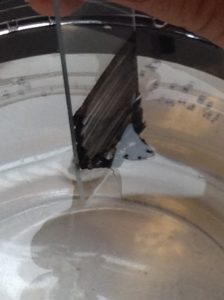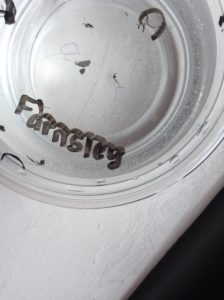By Jordan Miller And Kara Buckley; Farnsley Middle School (Louisville, KY)
One of the hardest things to remove from an object is permanent marker, and trust me we all love permanent marker until it’s time to get it off! We would scrub, scrub, scrub, scrub and nothing would come off, but researchers have shown a way to get the marker off glass surfaces and get a sticker in the end!
The scientists involved in this experiment were Professor Howard A. Stone, Sepideh Khodaparast, Christophe Poulard, and Francois Boulogne. This experiment took place at Princeton University in Princeton, NJ, U.S.A , but it wasn’t an actual experiment. It was accidentally discovered when the scientists were trying to remove particles and bacteria from a surface at the air-water interface—the area where the air and water meet then interact with each other.
Originally, Khodaparast and her team did this experiment in their lab because all of their permanent marker labels kept peeling off. They wanted to find out why.
They first wrote with a marker on different types of surfaces and studied whether the marker came off as a film. Then they tested it by moving the films only a fraction of a millimeter. If the water rises too fast, the water will just go over the film and the marker will not come off. They found out that permanent marker actually comes off of most surfaces, but especially glass and polystyrene surfaces. Once the marker was removed, the floating film can be transferred onto soft or delicate surfaces that might be hard to write upon. Finally, the researchers transferred markings onto a contact lens and left it to dry. This is quite important to the research because contact lens are typically very hard to write

on. Contact lens are delicate so that they don’t mess up your eyes,but being able to place the film over it is quite amazing.
In an email to SciJourner, Khodaparast says,” Adding some sort of soap to the water may decrease the effectiveness of the technique, while adding a more vicious or harsh liquid to water (such as glycerol) can increase the effectiveness of the technique at higher speeds of the peeling.”
The permanent marker comes off the glass, because when it is dipped into the water the film repels the water. The water wedges in between the film and the glass. The marker then peels off and floats on the water.
“The time all depends on the system and size of the film. 1 cm of a thin film can be peeled off in 1-10 seconds,” says Khodaparast in the same email. “Most people are familiar with such materials and they are advertised as permanent and water-proof, therefore they are expected to be resistant to water. So the fact that water can clean them from the surface is interesting.”

This technique works with most permanent, water-resistant markers. The researchers used the markers with the Sharpie brand because it is the one most commonly used in labs for labeling samples and because these markers create a fairly uniform, continuous film.
There are many other ways to get the marker off of a surface, but if you are doing it to get something like a sticker, this is the only way to do it. Although it isn’t a normal sticker, once you place it on an object it may not come off.
It appears that there is no other way to do this without making the marker smudge. Although it may not be the easiest way, it is the only way to get it off without smudging it or leaving behind debris.
Kodaparast told us in the email that, ” The recent development of new class hydrophobic [meaning to repel or fail to mix with water] materials has reduced the chance of using pure water as a cleanser and often solvents are required for this purpose that may not be environmental friendly. Moreover, there is an increasing demand for fabrication, transfer and layering of thin, soft elastic sheets in applications. such as flexible screens, soft and wearable electronics, thin solar cells, and etc.”
This may be important to you or your family because the development of these materials could require stronger and more harmful chemicals to remove and make it harder to remove these permanent markers ink from the films using only pure water.
We tried this experiment in class with Exposition Markers brand, which worked well and only took about 5 seconds to completely remove. We also tried it with Sharpie and it still worked very well, but took about 10x longer. We tried this experiment around 5 or 6 more times and got the same results each time. When the Expo marker was completely removed it would float on top of or in the water. If you touched it or dipped anything else into the water it would stick to it and when it dried it would be just like a temporary tattoo.

This work is licensed under a Creative Commons Attribution-NonCommercial-NoDerivs 3.0 Unported License.













